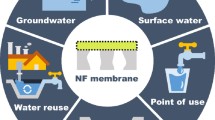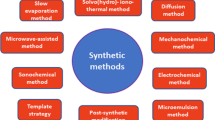Abstract
The right choice of porous support and diamine monomer is crucial in fabricating TFC membranes with improved performance. In this study, the effect of the supporting layer and diamine monomer structure in preparing TFC membranes for dye/salt separation was investigated. Supports used are polysulfone (PSf), polyacrylonitrile (PAN), and hydrolyzed PAN (mPAN) while diamine monomers used are piperazine (PIP), 1,3-diaminopropane (DAPE), and 1,4-bis(3-aminopropyl) piperazine (BAPP). Changing the porous substrate and monomer not only affects membrane physical and chemical morphology but also the performance of TFC NF membranes. Characterization and NF tests revealed that the TFC membrane prepared using mPAN as support and PIP as diamine monomer had most hydrophilic, roughest surface, and lowest crosslinking degree, and it delivered the optimum NF performance: J = 127.66 ± 12.61 LMH; RBrilliant Blue = 99.28 ± 0.57% RCongo Red = 99.21 ± 0.08%; RNaCl = 14.00 ± 6.16%.











Similar content being viewed by others
References
Boretti A, Rosa L (2019) Reassessing the projections of the World Water Development Report. NPJ Clean Water 2(1):1–6. https://doi.org/10.1038/s41545-019-0039-9
Mulder J (2012) Basic principles of membrane technology. Springer Science & Business Media
Safarpour M, Khataee A, Vatanpour V (2015) Thin film nanocomposite reverse osmosis membrane modified by reduced graphene oxide/TiO 2 with improved desalination performance. J Membr Sci 489:43–54. https://doi.org/10.1016/j.memsci.2015.04.010
Qi Y, Zhu L, Shen X, Sotto A, Gao C, Shen J (2019) Polythyleneimine-modified original positive charged nanofiltration membrane: Removal of heavy metal ions and dyes. Sep Purif Technol 222:117–124. https://doi.org/10.1016/j.seppur.2019.03.083
Cui J, Zhang X, Liu H, Liu S, Yeung KL (2008) Preparation and application of zeolite/ceramic microfiltration membranes for treatment of oil contaminated water. J Membr Sci 325(1):420–426. https://doi.org/10.1016/j.memsci.2008.08.015
Sardari K, Askegaard J, Chiao Y-H, Darvishmanesh S, Kamaz M, Wickramasinghe SR (2018) Electrocoagulation followed by ultrafiltration for treating poultry processing wastewater. J Environ Chem Eng 6(4):4937–4944. https://doi.org/10.1016/j.jece.2018.07.022
Mohammad AW, Teow YH, Ang WL, Chung YT, Oatley-Radcliffe DL, Hilal N (2015) Nanofiltration membranes review: Recent advances and future prospects. Desalination 356:226–254. https://doi.org/10.1016/j.desal.2014.10.043
Yao Y, Zhang P, Jiang C, DuChanois RM, Zhang X, Elimelech M (2020) High performance polyester reverse osmosis desalination membrane with chlorine resistance. Nat Sustain 4(2):138–146. https://doi.org/10.1038/s41893-020-00619-w
Tiraferri A, Yip NY, Phillip WA, Schiffman JD, Elimelech M (2011) Relating performance of thin-film composite forward osmosis membranes to support layer formation and structure. J Membr Sci 367(1–2):340–352. https://doi.org/10.1016/j.memsci.2010.11.014
Li Q, Beier L-J, Tan J, Brown C, Lian B, Zhong W, Wang Y, Ji C, Dai P, Li T, Le Clech P, Tyagi H, Liu X, Leslie G, Taylor RA (2019) An integrated, solar-driven membrane distillation system for water purification and energy generation. Appl Energy 237:534–548. https://doi.org/10.1016/j.apenergy.2018.12.069
Chiao Y-H, Cao Y, Ang MBMY, Sengupta A, Wickramasinghe SR (2022) Application of superomniphobic electrospun membrane for treatment of real produced water through membrane distillation. Desalination 528:115602. https://doi.org/10.1016/j.desal.2022.115602
Xue YL, Huang J, Lau CH, Cao B, Li P (2020) Tailoring the molecular structure of crosslinked polymers for pervaporation desalination. Nat Commun 11(1):1461. https://doi.org/10.1038/s41467-020-15038-w
Eriksson P (1988) Nanofiltration extends the range of membrane filtration. Environ Prog 7(1):58–62. https://doi.org/10.1002/ep.3300070116
Jiraratananon R, Sungpet A, Luangsowan P (2000) Performance evaluation of nanofiltration membranes for treatment of effluents containing reactive dye and salt. Desalination 130(2):177–183. https://doi.org/10.1016/s0011-9164(00)00085-0
Wang KY, Chung T-S, Qin J-J (2007) Polybenzimidazole (PBI) nanofiltration hollow fiber membranes applied in forward osmosis process. J Membr Sci 300(1–2):6–12. https://doi.org/10.1016/j.memsci.2007.05.035
Qian X, Ravindran T, Lounder SJ, Asatekin A, McCutcheon JR (2021) Printing zwitterionic self-assembled thin film composite membranes: Tuning thickness leads to remarkable permeability for nanofiltration. J Membr Sci 635:119428. https://doi.org/10.1016/j.memsci.2021.119428
Bera A, Trivedi JS, Jewrajka SK, Ghosh PK (2016) In situ manipulation of properties and performance of polyethyleneimine nanofiltration membranes by polyethylenimine-dextran conjugate. J Membr Sci 519:64–76. https://doi.org/10.1016/j.memsci.2016.07.038
Zhao Y, Tong T, Wang X, Lin S, Reid EM, Chen Y (2021) Differentiating Solutes with Precise Nanofiltration for Next Generation Environmental Separations: A Review. Environ Sci Technol 55(3):1359–1376. https://doi.org/10.1021/acs.est.0c04593
Yang Z, Zhou Y, Feng Z, Rui X, Zhang T, Zhang Z (2019) A review on reverse osmosis and nanofiltration membranes for water purification. Polym (Basel) 11(8). https://doi.org/10.3390/polym11081252
Ranganathan K, Karunagaran K, Sharma DC (2007) Recycling of wastewaters of textile dyeing industries using advanced treatment technology and cost analysis–Case studies. Resour Conserv Recycl 50(3):306–318. https://doi.org/10.1016/j.resconrec.2006.06.004
Ahmad NNR, Ang WL, Teow YH, Mohammad AW, Hilal N (2022) Nanofiltration membrane processes for water recycling, reuse and product recovery within various industries: A review. J Water Process Eng 45:102478. https://doi.org/10.1016/j.jwpe.2021.102478
Sontakke AD, Das PP, Mondal P, Purkait MK (2021) Thin-film composite nanofiltration hollow fiber membranes toward textile industry effluent treatment and environmental remediation applications: review. Emergent Mater. https://doi.org/10.1007/s42247-021-00261-y
Lau WJ, Ismail AF, Misdan N, Kassim MA (2012) A recent progress in thin film composite membrane: A review. Desalination 287:190–199. https://doi.org/10.1016/j.desal.2011.04.004
Song Y, Sun P, Henry L, Sun B (2005) Mechanisms of structure and performance controlled thin film composite membrane formation via interfacial polymerization process. J Membr Sci 251(1–2):67–79. https://doi.org/10.1016/j.memsci.2004.10.042
Ang MBMY, Ji YL, Huang SH, Tsai HA, Hung WS, Hu CC, Lee KR, Lai JY (2017) Incorporation of carboxylic monoamines into thin-film composite polyamide membranes to enhance nanofiltration performance. J Membr Sci 539:52–64. https://doi.org/10.1016/j.memsci.2017.05.062
Li L, Zhang SB, Zhang XS (2009) Preparation and characterization of poly(piperazineamide) composite nanofiltration membrane by interfacial polymerization of 3,3 ‘,5,5 ‘-biphenyl tetraacyl chloride and piperazine. J Membr Sci 335(1–2):133–139. https://doi.org/10.1016/j.memsci.2009.03.011
Ma X, Yang Z, Yao Z, Guo H, Xu Z, Tang CY (2019) Tuning roughness features of thin film composite polyamide membranes for simultaneously enhanced permeability, selectivity and anti-fouling performance. J Colloid Interface Sci 540:382–388. https://doi.org/10.1016/j.jcis.2019.01.033
Liu M, Chen Q, Lu K, Huang W, Lü Z, Zhou C, Yu S, Gao C (2017) High efficient removal of dyes from aqueous solution through nanofiltration using diethanolamine-modified polyamide thin-film composite membrane. Sep Purif Technol 173:135–143. https://doi.org/10.1016/j.seppur.2016.09.023
Prakash Rao A, Desai NV, Rangarajan R (1997) Interfacially synthesized thin film composite RO membranes for seawater desalination. J Membr Sci 124(2):263–272. https://doi.org/10.1016/s0376-7388(96)00252-9
Khoo YS, Lau WJ, Liang YY, Karaman M, Gürsoy M, Ismail AF (2020) A green approach to modify surface properties of polyamide thin film composite membrane for improved antifouling resistance. Sep Purif Technol 250:116976. https://doi.org/10.1016/j.seppur.2020.116976
Peng LE, Yao Z, Yang Z, Guo H, Tang CY (2020) Dissecting the role of substrate on the morphology and separation properties of thin film composite polyamide membranes: Seeing is believing. Environ Sci Technol 54(11):6978–6986. https://doi.org/10.1021/acs.est.0c01427
Saha NK, Joshi SV (2009) Performance evaluation of thin film composite polyamide nanofiltration membrane with variation in monomer type. J Membr Sci 342(1–2):60–69. https://doi.org/10.1016/j.memsci.2009.06.025
Cheng XQ, Shao L, Lau CH (2015) High flux polyethylene glycol based nanofiltration membranes for water environmental remediation. J Membr Sci 476:95–104. https://doi.org/10.1016/j.memsci.2014.11.020
Mansourpanah Y, Alizadeh K, Madaeni SS, Rahimpour A, Soltani H, Afarani (2011) Using different surfactants for changing the properties of poly(piperazineamide) TFC nanofiltration membranes. Desalination 271(1–3):169–177. https://doi.org/10.1016/j.desal.2010.12.026
Mi Y-F, Xu G, Guo Y-S, Wu B, An Q-F (2020) Development of antifouling nanofiltration membrane with zwitterionic functionalized monomer for efficient dye/salt selective separation. J Membr Sci 601:117795. https://doi.org/10.1016/j.memsci.2019.117795
Feng X, Liu D, Ye H, Peng D, Wang J, Han S, Zhang Y (2021) High-flux polyamide membrane with improved chlorine resistance for efficient dye/salt separation based on a new N-rich amine monomer. Sep Purif Technol 278:119533. https://doi.org/10.1016/j.seppur.2021.119533
Ding J, Wu H, Wu P (2020) Development of nanofiltration membranes using mussel-inspired sulfonated dopamine for interfacial polymerization. J Membr Sci 598:117658. https://doi.org/10.1016/j.memsci.2019.117658
Peng LE, Yang Z, Long L, Zhou S, Guo H, Tang CY (2022) A critical review on porous substrates of TFC polyamide membranes: Mechanisms, membrane performances, and future perspectives. J Membr Sci 641:119871. https://doi.org/10.1016/j.memsci.2021.119871
Ang MBMY, Lau VJ, Ji YL, Huang SH, An QF, Caparanga AR, Tsai HA, Hung WS, Hu CC, Lee KR, Lai JY (2017) Correlating PSf support physicochemical properties with the formation of piperazine-based polyamide and evaluating the resultant nanofiltration membrane performance. Polym (Basel) 9(10):505. https://doi.org/10.3390/polym9100505
De Guzman MR, Ang MBMY, Yeh Y-L, Yang H-L, Huang S-H, Lee K-R (2021) Improved pervaporation efficiency of thin-film composite polyamide membranes fabricated through acetone-assisted interfacial polymerization. Chem Eng Res Des 165:375–385. https://doi.org/10.1016/j.cherd.2020.11.016
Ang MBMY, Deang ABG, Chiao Y-H, Aquino RR, Millare JC, Huang S-H, Tsai H-A, Lee K-R (2022) Integrating nanoclay intercalated with interlayers of cationic surfactant into thin-film nanocomposite nanofiltration membranes to improve performance and antifouling property. Sep Purif Technol 285:120360. https://doi.org/10.1016/j.seppur.2021.120360
Ang MBMY, Huang SH, Li YC, Cahatol ATC, Tayo LL, Hung WS, Tsai HA, Hu CC, Lee KR, Lai JY (2020) High-performance thin-film composite polyetheramide membranes for the dehydration of tetrahydrofuran. J Membr Sci 611:118373. https://doi.org/10.1016/j.memsci.2020.118373
Jin SY, Kim MH, Jeong YG, Yoon YI, Park WH (2017) Effect of alkaline hydrolysis on cyclization reaction of PAN nanofibers. Mater Des 124:69–77. https://doi.org/10.1016/j.matdes.2017.03.066
Ding H-z, Xie F, Wang Z-y, Huang W, Ma X-h (2022) Xu, 2D nanosheets optimized electrospray-assisted interfacial polymerization polyamide membrane with excellent separation performance. J Membr Sci 647:120308. https://doi.org/10.1016/j.memsci.2022.120308
Kong J, Zhu Y, Dong D, Jin J (2022) Ultrapermeable polyamide nanofiltration membrane formed on a self-constructed cellulose nanofibers interlayer. Chem Eng Res Des 179:249–256. https://doi.org/10.1016/j.cherd.2022.01.032
Acknowledgements
The authors would like to acknowledge the Ministry of Science and Technology of Taiwan (MOST 108-2218-E-033 -007 -MY3, MOST 109-2811-E-033-501 MOST 110-222-E-033 -012, and MOST 110-2221-E-197-006-MY3) for the financial support in this study.
Author information
Authors and Affiliations
Corresponding authors
Ethics declarations
The authors declare that they have no known competing financial interests or personal relationships that could have appeared to influence the work reported in this paper.
Additional information
Publisher’s Note
Springer Nature remains neutral with regard to jurisdictional claims in published maps and institutional affiliations.
Rights and permissions
About this article
Cite this article
Wu, PH., Gallardo, M.R., Ang, M.B.M.Y. et al. Assessing the impact of membrane support and different amine monomer structures on the efficacy of thin-film composite nanofiltration membrane for dye/salt separation. J Polym Res 29, 270 (2022). https://doi.org/10.1007/s10965-022-03126-y
Received:
Accepted:
Published:
DOI: https://doi.org/10.1007/s10965-022-03126-y




